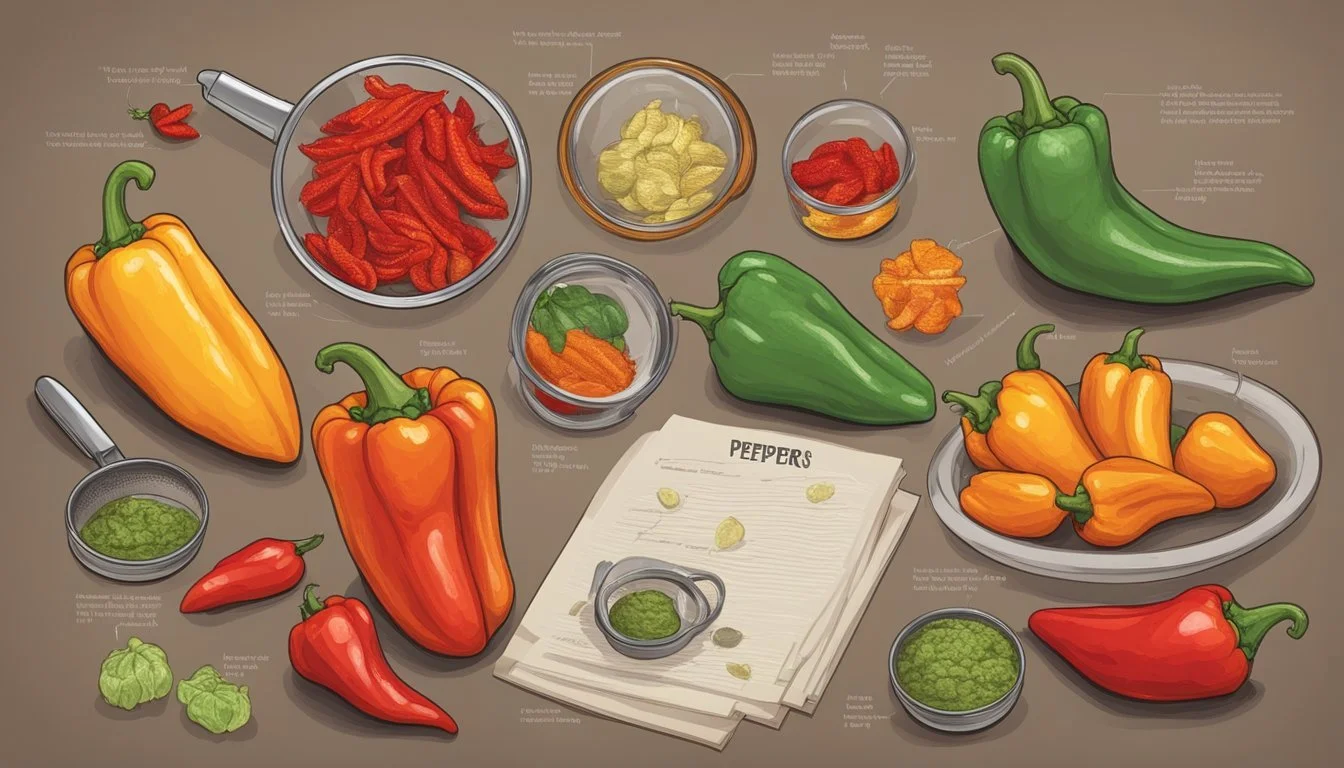Ghost Peppers Substitutes
Top Alternatives for Scorching Heat
Ghost peppers, known for their extreme heat and distinctive flavor, can be a challenge to find or use in many recipes. Sometimes, finding the right substitute is essential for achieving a balance between heat and flavor without overwhelming the dish. Habanero peppers serve as an excellent substitute for ghost peppers when looking to maintain a fiery kick but with a more manageable heat level.
For those who crave even more intensity, the Carolina Reaper pepper is the perfect alternative, offering a spicier experience than ghost peppers. Using these substitutes can provide the versatility needed in various culinary applications, from seasoning meats to enhancing sauces. Experimenting with these options ensures that the desired heat and flavor profile is achieved, no matter the recipe.
Understanding Ghost Peppers
Ghost peppers are famous for their extreme heat and are a popular choice among chili enthusiasts. Known for their intense Scoville rating, these peppers boast a rich history and unique characteristics, along with notable health benefits.
Origins and History
Ghost peppers, also known as Bhut Jolokia, originate from the Northeast India region, specifically Assam and Nagaland. They gained international fame in 2007 when they were recognized by the Guinness World Records as the world's hottest pepper.
Native to the regions around Assam and Nagaland, ghost peppers have been cultivated for centuries. The name "Bhut Jolokia" translates to "ghost chili," reflecting their enigmatic nature and the fact that their heat seems to linger like a ghost.
Characteristics
Ghost peppers are distinguishable by their elongated, wrinkled appearance. They typically range from 2 to 3 inches in length and change color as they ripen, transitioning from green to vibrant red, orange, or brown.
The key feature of ghost peppers is their extreme heat. They rank extraordinarily high on the Scoville scale, with Scoville heat units (SHUs) ranging from 855,000 to over 1,000,000. This heat comes from the high capsaicin content, making them significantly hotter than many other chili varieties like the habanero.
Nutrition and Health Benefits
Ghost peppers are not just about heat; they also offer several health benefits. They are rich in vitamin C, which supports immune function and skin health. Additionally, the capsaicin found in ghost peppers has been linked to boosting metabolism and aiding in weight loss.
Capsaicin can also provide pain relief by desensitizing nerve receptors. Moreover, ghost peppers have antimicrobial properties that can contribute to food preservation and safety. Despite their fiery reputation, consuming ghost peppers in moderation can be a nutritious addition to a balanced diet.
Ghost Pepper Substitutes
Choosing the right substitute for ghost peppers depends on achieving the desired balance of heat and flavor. Various peppers offer distinct profiles suitable for different culinary applications, whether you need intense heat or a more nuanced taste.
Heat and Flavor Profiles
Ghost peppers, or Bhut Jolokia, have a Scoville Heat Unit (SHU) rating between 855,000 to 1,041,427. This intense heat is coupled with a fruity and smoky flavor, making them a staple in extreme heat applications. Compared to other hot peppers, ghost peppers are significantly hotter than habanero peppers, which range from 100,000 to 350,000 SHU, and Carolina Reapers, which exceed 1,400,000 SHU. This heat level makes ghost peppers ideal for very spicy sauces and salsas, but too intense for many everyday dishes.
Habanero peppers offer a fruity and floral aroma with a more balanced heat that is less overwhelming. The smokiness and sweetness inherent to ghost peppers are somewhat unique but can be mimicked with the right combinations. Understanding these profiles helps in choosing an appropriate substitute.
Substitute Options
Habanero Peppers: These are a popular substitute due to their fruity flavor and substantial, though lesser, heat. They work well in sauces and salsas where a milder spice level is acceptable.
Scotch Bonnet Peppers: Similar in heat to habaneros, Scotch Bonnets provide a slightly sweeter profile. These peppers are excellent for spicy Caribbean dishes.
Cayenne Peppers: With a heat level of 30,000 to 50,000 SHU, cayenne peppers offer a significant drop in spiciness but can add a sharp, intense heat. They are best used in powdered form for consistent heat.
Jalapeno and Serrano Peppers: These mild alternatives (2,500 to 8,000 SHU for jalapenos and 10,000 to 23,000 SHU for serranos) are great for those seeking a milder heat with a fresh, green flavor. Ideal for salsas and pickling.
Banana Peppers: Extremely mild (0 to 500 SHU), these are not suitable for those seeking significant heat but can add a sweet and tangy flavor to dishes.
Choosing the right substitute depends on the desired flavor and heat level, ensuring the dish maintains its intended character while accommodating different spice tolerances.
Culinary Applications
Ghost pepper substitutes can expand the variety in your culinary pursuits, adapting recipes for different heat levels and flavor profiles. Explore ways to incorporate these substitutes in various dishes, sauces, and salsas.
Incorporating Substitutes in Recipes
Incorporating substitutes like habanero peppers or Carolina Reaper peppers can diversify the flavor and spice in your cooking. Habanero peppers offer a fruity, floral aroma and less intense heat than ghost peppers, making them ideal for those seeking to balance flavor and spice. They are perfect for marinades, curries, soups, and stews, providing a fiery kick without overwhelming the dish.
On the other hand, Carolina Reaper peppers are excellent for those who crave extreme heat. Their intense spice and smoky flavor can greatly enhance dishes such as chili, spicy barbecue sauces, and meat rubs. Always handle these peppers with caution, using gloves and protective gear, as the oils can cause intense chili burn.
Sauce and Salsa Making
Making sauces and salsas with ghost pepper substitutes can yield exciting variations in heat and flavor. Substituting with habanero peppers creates a mildly spicy salsa with a distinct fruity undertone, ideal for pairing with chips, tacos, or grilled meats. For hot sauces, habanero peppers blend well with ingredients like mango, lime, and vinegar, resulting in a tangy and robust sauce.
For those preferring an even spicier kick, using Carolina Reaper peppers can produce some of the hottest sauces and salsas. These can be mixed with tomatoes, onions, and cilantro for a salsa that's bursting with heat and flavor. When making hot sauces, blending Carolina Reaper peppers with garlic and spices can deliver a powerful, smoky condiment suitable for adding an intense spice to any dish.
Safety and Handling
When working with ghost peppers, several critical safety measures should be observed to prevent injury and preserve the peppers' potency and flavor. This includes using appropriate gloves and storing the peppers correctly.
Proper Usage of Gloves
Handling ghost peppers without gloves can cause severe irritation and burns due to their intense heat. Proper gloves are essential for safety. Latex or nitrile gloves are recommended because they provide a barrier against the capsaicin—the compound responsible for the pepper’s heat.
Ensure the gloves fit snugly to avoid slipping.
Check the gloves for holes or tears before use.
Avoid touching your face, especially the eyes, when wearing gloves.
Removing the gloves properly is equally important. Pinch one glove at the palm and remove it, then slide ungloved fingers under the remaining glove to peel it off without touching the outer surface. Dispose of gloves immediately after use and thoroughly wash hands.
Storing and Preserving Peppers
Proper storage and preservation techniques help maintain the quality and heat of ghost peppers. Whether they are fresh or dried, storage in airtight containers is crucial.
For fresh ghost peppers:
Keep in the refrigerator’s crisper drawer.
Place in a breathable bag or container to prevent moisture buildup.
For dried ghost peppers:
Use a dehydrator or an oven at the lowest setting to dry until brittle.
Store in an airtight container away from light and moisture to retain heat and flavor.
When pickling ghost peppers, ensure they are fully submerged in a vinegar-based solution to inhibit bacterial growth. Properly stored, fresh ghost peppers last about two weeks, while dried peppers can maintain their potency for several months. Always label containers with dates to track freshness.
Beyond The Heat
Ghost peppers, known for their intense spiciness, also have rich cultural significance, unique growing conditions, and diverse culinary uses.
Cultural Significance
Originating from India, the ghost pepper, or Bhut Jolokia, holds a special place in local cultures, especially in Assam. It's used in traditional recipes and sometimes in belief systems and rituals. Its reputation extends beyond India, impacting global culinary practices.
Widely recognized in the culinary world, the ghost pepper gained fame through various spice contests and challenges, embedding itself into popular culture.
Growing Ghost Peppers
Ghost peppers belong to the Capsicum chinense species. They thrive in hot, humid climates, typical of their native regions in Northeast India. Soil should be well-drained and rich in organic matter.
Regular watering and full sunlight are crucial. These peppers require a long growing season, often taking over 100 days to mature. Maintaining consistent temperatures helps ensure a healthy crop.
Other Uses in Cuisine
Apart from their fiery profile, ghost peppers add depth to dishes. They are often used in hot sauces, salsas, and marinades, providing a unique fruity flavor along with heat.
In India, they are incorporated into meat dishes and egg preparations, adding a distinctive punch. The nutritional value includes vitamins A and C, and capsaicin, known for its metabolism-boosting properties.
Finding Substitutes at the Store
When looking to replace ghost peppers, grocery stores offer various alternatives that can meet your desired level of heat and flavor. This guide will help you navigate the options available, including common substitutes that are easily found.
Navigating the Grocery Aisles
Navigating the grocery store aisles can be daunting when searching for the right pepper substitutes. Spicy peppers are usually stocked in the produce section near other fresh vegetables. Look for aisles dedicated to international foods, where you might find specialty hot sauces and salsa that utilize different types of peppers.
Packaged spices and dried pepper options are often found in the spices aisle. Here, you'll find cayenne pepper which can be a versatile replacement for ghost peppers in many recipes.
Commonly Available Alternatives
Several commonly available peppers can easily substitute for ghost peppers.
Jalapeño: Offers moderate heat and a crisp texture, great for fresh salsas.
Habanero: Similar fruity flavor with a significant heat level, excellent for hot sauces.
Cayenne Pepper: Available in both fresh and powdered forms, ideal for adding a sharp heat to dishes.
Serrano: Slightly hotter than jalapeños, preferred for an enhanced spice profile.
Bell Pepper: Not spicy but can add bulk and a slight sweetness in salsa, preserving the overall aesthetic and texture.
Finding the right substitute involves considering both the recipe and your heat tolerance.
Conclusion
Ghost peppers, with their intense heat, can be overwhelming for many. Fortunately, there are several substitutes that can be used in cooking to adjust the spice level according to taste.
Popular substitutes include:
Jalapeño Peppers: Milder in heat, perfect for those who prefer a gentler spice.
Habanero Peppers: Slightly less hot with a fruity flavor, making them a versatile option.
Chipotle Peppers: Smoky and moderately spicy, ideal for adding depth to dishes.
Spice Level Comparison:
Pepper Scoville Heat Units (SHU) Ghost Pepper 855,000 - 1,041,427 Habanero 100,000 - 350,000 Jalapeño 2,500 - 8,000 Chipotle 2,500 - 8,000
When substituting ghost peppers, the choice depends on the desired level of heat and flavor complexity. For those aiming to maintain high heat, habanero peppers are a good choice. For a more subdued spice, jalapeños or chipotles can be used.
Ghost pepper powders and jellies offer additional ways to incorporate the unique flavor without committing to the intense heat of the fresh pepper. Experimenting with various peppers can help achieve the desired balance of spice in any recipe.









